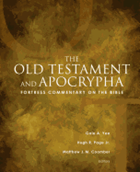 The Fortress Commentary on the Bible: The Old Testament and Apocrypha brings a diversity of perspectives and interpretations with the primary focus on a historical and cultural analysis of the text. It demonstrates a broad range of theological ideas and interpretations.
The Fortress Commentary on the Bible: The Old Testament and Apocrypha brings a diversity of perspectives and interpretations with the primary focus on a historical and cultural analysis of the text. It demonstrates a broad range of theological ideas and interpretations.
How the Commentary is Structured
Topical Articles
Covers issues and concerns that shape historical and theological scholarship to the present time. Sets the stage for interpretation. Shows how two different religious communities interpret the same passage differently.
Section Introductions
OT Sections include Torah, Historical Writings, Wisdom, Prophetic Writings, and Apocrypha.
Addresses literary and historical matters, and theological themes, that these books hold in common
Commentary Entries
Includes current thinking about the original context, and significance in different reading communities through history to the present day.
Interpretations
The commentary recognizes the difference between ancient and modern contexts. It takes into consideration how readers would understand and apply texts based on their current situation. For example, the Israelite’s application of Leviticus compared to our understanding of the Law.
It also take into account ideology and how it affects interpretation. The authors have vowed to not interpret a text based on what they want it to say, but rather what the context and culture understood it to say.
A lot of effort is spent explaining and describing the ancient context and interpretation. I like that they’ve gone through so much trouble to explain this because it helps the reader to know where and how the commentator is getting and using the information.
Articles
The book starts with several articles that talk about the Old Testament itself. This section covers information about monotheism, defining Elohim, YHWH, El, etc. It also discusses textual criticism. There is a long list of cited works for reference. There are lots of articles before the commentary even begins. Genesis starts on page 89, after the introductory articles.
Book Introductions
There is an introduction to each book that covers the name of the book and its location within the canon, authorship, date, literary history, historical context, structure and contents, and reception history. There is a lot of information in these introductions spanning around five pages.
The Commentary
The commentary covers passages of text that usually span a chapter or so. It starts with a section called The Text in its Ancient Context. It discusses the setting. The next section is The Text in the Interpretive Tradition. It covers have the text has been traditionally interpreted by early writers and teachers. Next is The Text in Contemporary Discussion. This section gives information about how the text has been applied today.
How I Used It
I did a search for Shema (Dt. 6:4). The section that discussed Dt. 6:4 is called Deuteronomy 5:1-6:19: Faithfulness to YHWH. Most of the information that dealt directly with the Shema was under the section The Text in its Ancient Context. The information given discussed the role of monotheism in ancient times. The information was interesting and helpful. It wasn’t what you would normally find in a study Bible.
I also research the creation account. The information here was overwhelming. It gives a lot of Hebrew definitions and tons of information about traditional interpretations.
For this review I used the PDF edition. This was a secured digital edition that was useable for 60 days. One issue I had with the file itself was my review file didn’t have a table of contents. That might not be the case for the actual file, but I don’t know that. Search worked just find and I was able to navigate to anything I wanted by typing in the chapter and verse or the words I wanted to search. Without the navigation I wasn’t sure where I was within the book even after I searched. It wasn’t too difficult to figure out and this didn’t keep me from using it.
Conclusion
At 1142 pages, there is a lot of commentary to work through and consider. The commentary is well written and the structure is easy to follow. Most of the information is historical based. They tell what someone believed rather than telling you what you should believe. The point of the commentary seems to focus on an in-depth analysis of the text rather than promoting a specific doctrine. The writing style and quality is aimed toward scholars.
Where to Buy: Fortress Commentary on the Bible: The Old Testament and Apocrypha
Edelweiss provided this preview file free for review. I was not required to give a positive review – only an honest review.











Recent Comments